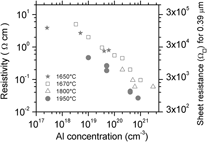Crossref Citations
This article has been cited by the following publications. This list is generated based on data provided by
Crossref.
Parisini, A.
and
Nipoti, R.
2013.
Analysis of the hole transport through valence band states in heavy Al doped 4H-SiC by ion implantation.
Journal of Applied Physics,
Vol. 114,
Issue. 24,
Nipoti, Roberta
Moscatelli, Francesco
and
De Nicola, Pietro
2013.
${\rm Al}^{+}$ Implanted 4H-SiC ${\rm p}^{+}$-i-n Diodes: Forward Current Negative Temperature Coefficient.
IEEE Electron Device Letters,
Vol. 34,
Issue. 8,
p.
966.
Nath, Anindya
Parisini, Antonella
Tian, Yong Lai
Rao, Mulpuri V.
and
Nipoti, Roberta
2014.
Microwave Annealing of Al<sup>+</sup> Implanted 4H-SiC: Towards Device Fabrication.
Materials Science Forum,
Vol. 778-780,
Issue. ,
p.
653.
Alam, M. T.
Pulavarthy, R. A.
Bielefeld, J.
King, S. W.
and
Haque, M. A.
2014.
Thermal Conductivity Measurement of Low-k Dielectric Films: Effect of Porosity and Density.
Journal of Electronic Materials,
Vol. 43,
Issue. 3,
p.
746.
Ayedh, H. M.
Bobal, V.
Nipoti, R.
Hallén, A.
and
Svensson, B. G.
2014.
Formation of carbon vacancy in 4H silicon carbide during high-temperature processing.
Journal of Applied Physics,
Vol. 115,
Issue. 1,
Nath, A.
Rao, Mulpuri V.
Tian, Y. -L.
Parisini, A.
and
Nipoti, R.
2014.
Microwave Annealing of High Dose Al+-implanted 4H-SiC: Towards Device Fabrication.
Journal of Electronic Materials,
Vol. 43,
Issue. 4,
p.
843.
Grossner, Ulrike
Moscatelli, Francesco
and
Nipoti, Roberta
2014.
Al<sup>+ </sup>Implanted 4H-SiC p<sup>+</sup>-i-n Diodes: Evidence for Post-Implantation-Annealing Dependent Defect Activation.
Materials Science Forum,
Vol. 778-780,
Issue. ,
p.
657.
Nath, A.
Rao, Mulpuri V.
Moscatelli, F.
Puzzanghera, M.
Mancarella, F.
and
Nipoti, R.
2014.
Temperature dependent current-voltage characteristics of microwave annealed Al<sup>+</sup> implanted 4H-SiC p<sup>+</sup>-i-n diodes.
p.
1.
Di Benedetto, Luigi
Licciardo, Gian Domenico
Nipoti, Roberta
and
Bellone, Salvatore
2014.
On the Crossing-Point of 4H-SiC Power Diodes Characteristics.
IEEE Electron Device Letters,
Vol. 35,
Issue. 2,
p.
244.
Nipoti, R.
Puzzanghera, M.
and
Moscatelli, F.
2014.
P+ implanted 6H-SiC n+-i-p diodes: evidence for a post-implantation-annealing dependent defect activation.
MRS Proceedings,
Vol. 1693,
Issue. ,
Nipoti, Roberta
Moscatelli, Francesco
Roncaglia, Alberto
Bonafè, Filippo
Mancarella, Fulvio
de Nicola, Pietro
Nath, Anindya
and
Rao, Mulpuri V.
2015.
Ion Implanted Lateral p<sup>+</sup>-i-n<sup>+</sup> Diodes on HPSI 4H-SiC.
Materials Science Forum,
Vol. 821-823,
Issue. ,
p.
620.
Ji, Shiyang
Eto, Kazuma
Yoshida, Sadafumi
Kojima, Kazutoshi
Ishida, Yuuki
Saito, Shingo
Tsuchida, Hidekazu
and
Okumura, Hajime
2015.
Hopping conduction range of heavily Al-doped 4H-SiC thick epilayers grown by CVD.
Applied Physics Express,
Vol. 8,
Issue. 12,
p.
121302.
Ayedh, H. M.
Nipoti, R.
Hallén, A.
and
Svensson, B. G.
2015.
Elimination of carbon vacancies in 4H-SiC employing thermodynamic equilibrium conditions at moderate temperatures.
Applied Physics Letters,
Vol. 107,
Issue. 25,
Parisini, A.
Gorni, M.
Nath, A.
Belsito, L.
Rao, Mulpuri V.
and
Nipoti, R.
2015.
Remarks on the room temperature impurity band conduction in heavily Al+ implanted 4H-SiC.
Journal of Applied Physics,
Vol. 118,
Issue. 3,
Parisini, Antonella
and
Nipoti, Roberta
2015.
About the Hole Transport Analysis in Heavy Doped p-Type 4H-SiC(Al).
Materials Science Forum,
Vol. 821-823,
Issue. ,
p.
416.
Grossner, Ulrike
Alfieri, Giovanni
and
Nipoti, Roberta
2015.
SiC Device Manufacturing: How Processing Impacts the Material and Device Properties.
Materials Science Forum,
Vol. 821-823,
Issue. ,
p.
381.
Nipoti, Roberta
Parisini, Antonella
Carnera, Alberto
Albonetti, Cristiano
Vantaggio, Salvatore
and
Grossner, Ulrike
2015.
Al<sup>+</sup> Ion Implanted On-Axis <0001> Semi-Insulating 4H-SiC.
Materials Science Forum,
Vol. 821-823,
Issue. ,
p.
399.
Nipoti, Roberta
Parisini, Antonella
Sozzi, Giovanna
Puzzanghera, Maurizio
Parisini, Andrea
and
Carnera, Alberto
2016.
Structural and Functional Characterizations of Al+Implanted 4H-SiC Layers and Al+Implanted 4H-SiCp-nJunctions after 1950°C Post Implantation Annealing.
ECS Journal of Solid State Science and Technology,
Vol. 5,
Issue. 10,
p.
P621.
Fedeli, P.
Gorni, M.
Carnera, A.
Parisini, A.
Alfieri, G.
Grossner, U.
and
Nipoti, R.
2016.
1950°C Post Implantation Annealing of Al+Implanted 4H-SiC: Relevance of the Annealing Time.
ECS Journal of Solid State Science and Technology,
Vol. 5,
Issue. 9,
p.
P534.
Fedeli, P.
Puzzanghera, Maurizio
Moscatelli, Francesco
Minamisawa, Renato Amaral
Alfieri, Giovanni
Grossner, Ulrike
and
Nipoti, Roberta
2017.
Ni-Al-Ti Ohmic Contacts on Al Implanted 4H-SiC.
Materials Science Forum,
Vol. 897,
Issue. ,
p.
391.





